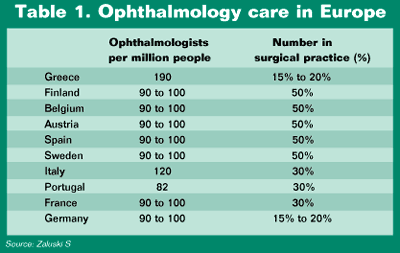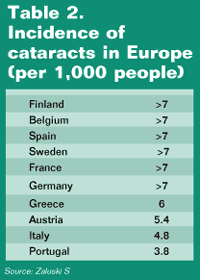French survey links low compensation rates with declining quality of care
Widely differing health care systems make comparison of fees and reimbursement rates for cataract surgery in Europe difficult.
PARIS – Substantial differences among the health care systems of European countries make reimbursement rates for cataract surgery difficult to compare, according to a survey conducted by French ophthalmologists. However, a constant factor that emerged from the survey is that wherever compensation is low, the quality of care is declining.
“Collecting data from our European colleagues was not as straightforward as we thought,” said Serge Zaluski, MD, speaking at the meeting of the French Society of Ophthalmology.
According to Dr. Zaluski, the survey data, which he and his colleague Guy Aflalo, MD, collected, was difficult to attain because of considerable differences in health care from region to region and from country to country. Therefore, the results were “incomplete and very approximate,” he said.
“We would like to make this information more complete and reliable, and we’ll be grateful to all European colleagues who can contribute with new data,” he said.
Public vs. private care
 Most European countries provide health care coverage for all of their citizens, Dr. Zaluski said. In these countries, where all employed people pay into a national health insurance fund, health service providers are reimbursed for procedures and examinations. The rate of copayment that citizens contribute is variable, and may apply to medications, procedures, examinations or hospitalization, he said.
Most European countries provide health care coverage for all of their citizens, Dr. Zaluski said. In these countries, where all employed people pay into a national health insurance fund, health service providers are reimbursed for procedures and examinations. The rate of copayment that citizens contribute is variable, and may apply to medications, procedures, examinations or hospitalization, he said.
However, there are countries in which private insurance companies play a significant role in health care delivery, Dr. Zaluski explained. Private health care insurance can either be an alternative to the national health service or a supplemental policy patients use to expand access to services and a differentiated level of care, he said.
The private practice of medicine is well-established in a large part of Europe, but the ratio of public vs. private care depends on location. Most European countries have many privately owned and operated medical centers, where patients pay out-of-pocket for services, Dr. Zaluski said.
Private health centers that meet regulatory requirements within a country may also be accredited by the country’s national health insurance fund, which then provides reimbursement for services rendered on their premises, he continued.
Medical services covered by national health insurance agencies are determined by governmental health authorities in each country. The same procedure might therefore be reimbursed entirely, partly or not at all, depending on where the procedure is performed, Dr. Zaluski said.
Survey overview
The demographic data provided by the survey showed that in most European countries the number of ophthalmologists per million people is between 90 and 100. The ratio is slightly lower in Portugal and higher in Italy and Greece. Of the total number of ophthalmologists, between 15% and 50% of those doctors practice surgery, depending on where they practice, the survey found (Table 1).
According to Dr. Zaluski, the incidence of cataracts is higher in Europe’s most industrialized nations. However, the rest of Europe is experiencing an upward trend, he said (Table 2).
Survey results showed that cataract surgery is mostly performed in hospitals, and is covered by national health insurance funds. France and Germany have the highest numbers of cataract patients electing to have surgery in private clinics, with or without coverage from national or private health insurance, Dr. Zaluski said.
“Wherever patients are mostly relying on public hospital care, without significant relief provided by private clinics, there are often long waiting lists for cataract surgery. Six months is the average time, but there are patients who have to wait up to 1.5 years for surgery,” he said.
Variable rates
According to Dr. Zaluski, the information gathered from European colleagues was difficult to interpret and to summarize under common categories. Fees and reimbursement for cataract surgery varied widely.
“The remuneration of single operations cannot be calculated for most of the ophthalmologists working in public hospitals because they are generally paid an all-inclusive monthly salary. On the other hand, in countries with a free market system, private practices may offer very variable rates to their patients. Moreover, the fee for the procedure might or might not include the use of upgraded technology, like phaco or some types of IOLs,” he said.
According to Dr. Zaluski, since the data acquired by the survey were so diverse, each of the countries that contributed to the study needed to be presented separately. The following information encompasses only some of the countries mentioned in Dr. Zaluski’s presentation.
Sweden, Finland and Belgium
 The survey found that in Sweden, 97% of cataract surgery is performed in public hospitals. The cost of the operation (all-inclusive) is about U.S. $930 and is entirely reimbursed by national insurance. The percentage allotted to the surgeon was not declared, Dr. Zaluski said.
The survey found that in Sweden, 97% of cataract surgery is performed in public hospitals. The cost of the operation (all-inclusive) is about U.S. $930 and is entirely reimbursed by national insurance. The percentage allotted to the surgeon was not declared, Dr. Zaluski said.
In Finland, the average rate for cataract surgery, including hospitalization, is about U.S. $2,070, according to the survey. Private ambulatory surgery, which accounts for about 20% of all cataract operations, costs about U.S. $1,770.
In Belgium, cataract surgery is mostly carried out in public hospitals, but surgeons are paid a fixed amount on top of their basic salary. According to the survey, surgeons receive approximately U.S. $470 for each cataract extraction with IOL implantation, and a supplement of about U.S. $150 for phacoemulsification.
“Phaco is considered a deluxe procedure, and this supplement cannot be reimbursed to the patient,” he explained.
Private practices in Belgium are mostly free, non-accredited medical centers, and ophthalmologists can charge higher fees for cataract surgery, he added.
Germany, Austria and Italy
According to Dr. Zaluski, Germany shows an almost equal number of public and private medical care in relation to cataract surgery.
“Fees are extremely variable and difficult to calculate, because they change according to the region and to the type of insurance the patient has taken out,” he said.
On average, fees in Germany vary from U.S. $850 to U.S. $1,460. Private practitioners have significant freedom in billing rates that are almost double the reimbursement rate to patients who can afford such rates, Dr. Zaluski said.
However, governmental health policies in Germany have recently started to focus on controlling costs and increasing profitability, he said. According to the German doctors surveyed, this has resulted in lower reimbursement rates for surgeons and lower levels of care for patients.
The survey showed that, in Austria, the public health insurance system pays U.S. $1,220 for the surgical procedure, plus an additional U.S. $610 to U.S. $1,220 per overnight stay if the patient needs hospitalization.
“The 10% to 20% of [Austrian] patients who resort to purely private medical care pay about U.S. $2,500 for the procedure and about U.S. $610 for an overnight stay,” he said.
The fee in Italian hospitals is U.S. $1,100 for outpatient and U.S. $1,580 for inpatient surgery, the survey reported. Private ambulatory cataract surgery, which accounts for about 15% of the total, costs the patient a minimum of U.S. $1,580 for a routine procedure. Other costs related to technology upgrades and deluxe implants are not included, he said.
Spain and France
In Spain, only 10% of cataract patients currently opt for private medical care, but this rate is growing fast, according to surveyed Spanish ophthalmologists.
Fees and reimbursement rates are difficult to calculate because, like Germany, Spain has different regional regulations and a variety of health insurance policies, Dr. Zaluski said. Private medical centers can negotiate reimbursement rates with insurance companies, or work on a purely private basis, he explained.
In Spain’s public hospitals, the cost of cataract surgery for the patient varies between U.S. $1,220 and U.S. $2,440, with the surgeons allotted U.S. $240 to U.S. $490 for each procedure.
Among the European nations included in the survey, France had the highest number of cataract patients (75% to 80%) resorting to private medical care. The cost for the operation is about U.S. $2,190 in hospitals and U.S. $1,460 in private clinics, according to Dr. Zaluski.
For Your Information:
- Serge Zaluski, MD, can be reached at 8 Espace Méditerranée, 66000 Perpignan, France; 33-4-683-59270; fax: 33-4-683-59279. To contribute data to Drs. Zaluski and Aflalo’s European cataract survey, e-mail: serge.zaluski@ophtalmo.net.
- OSN Correspondent Michela Cimberle is based in Asolo, Italy.
